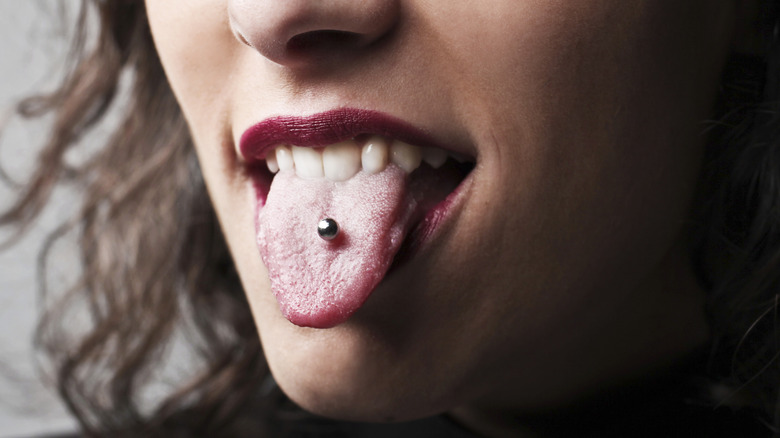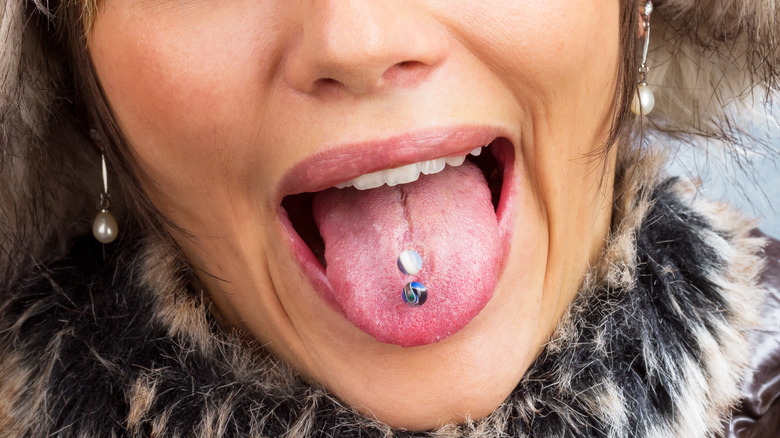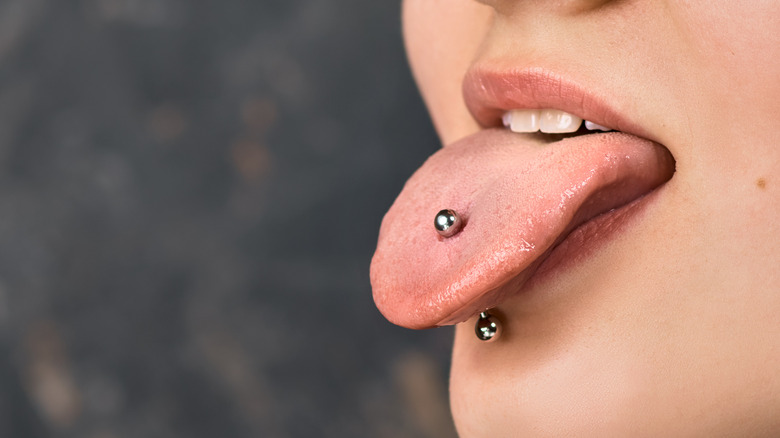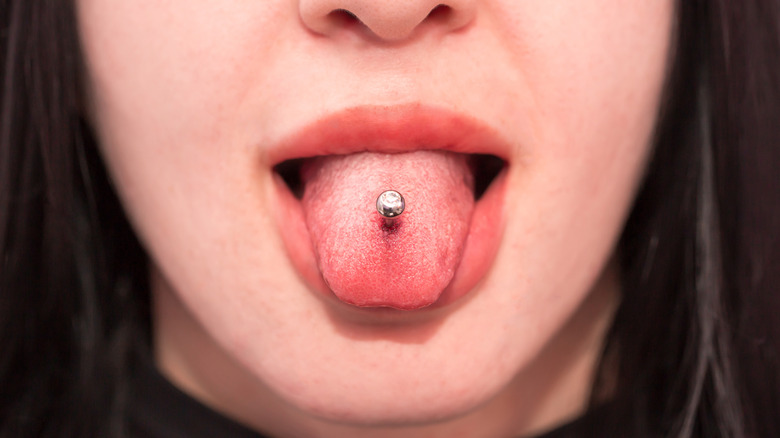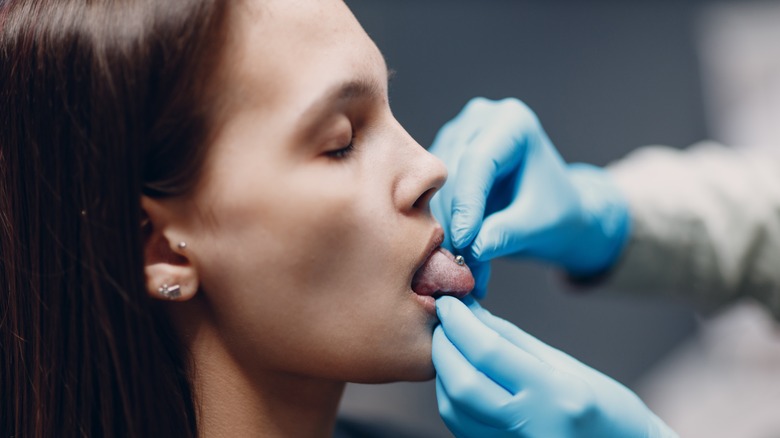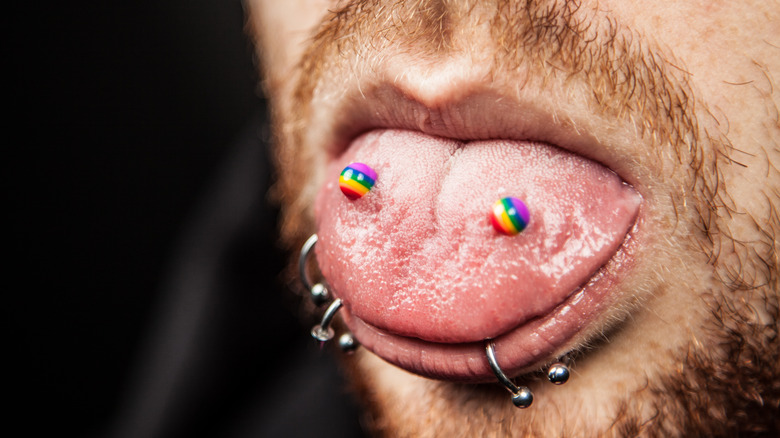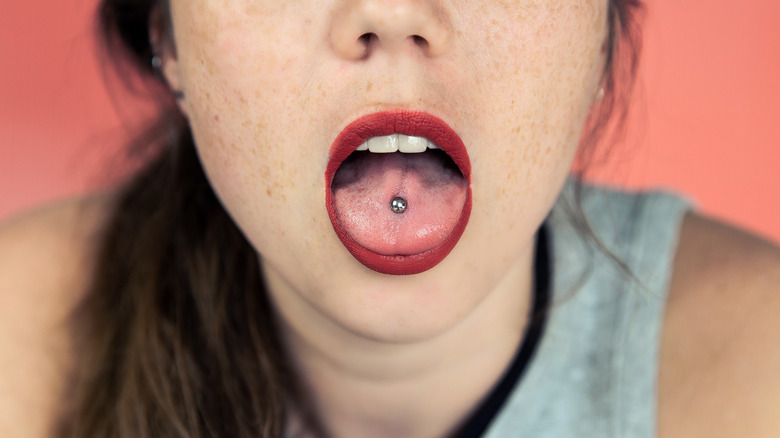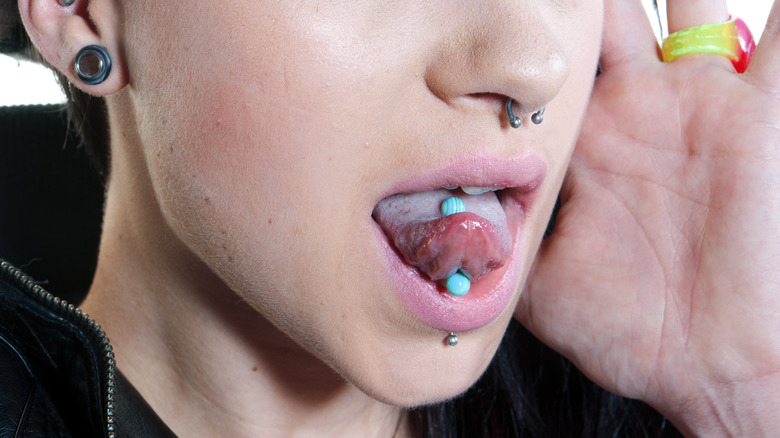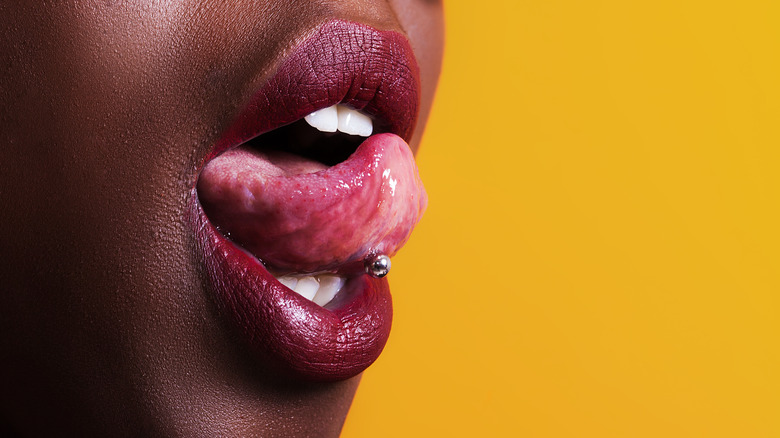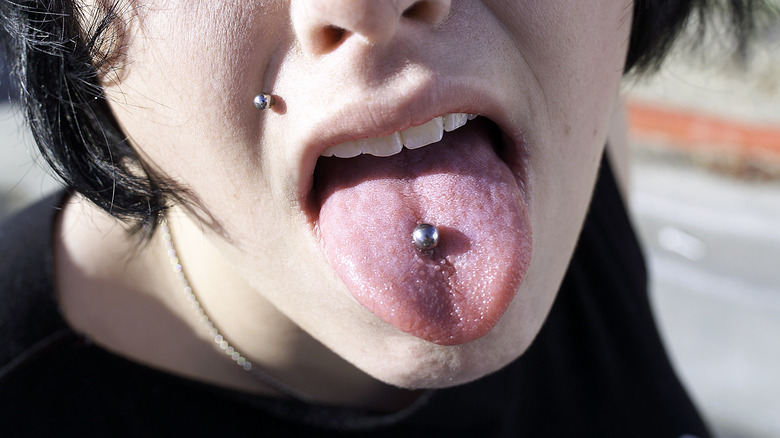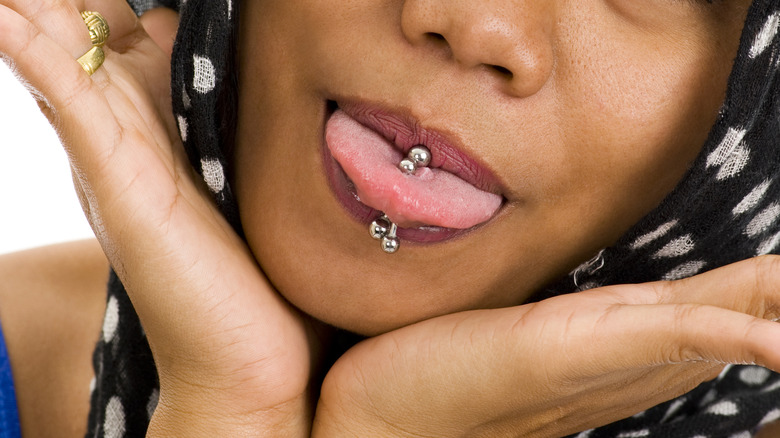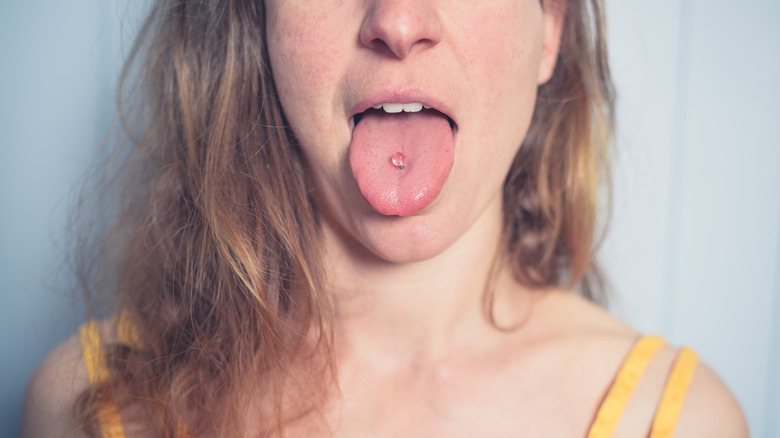Your Most Common Questions About Tongue Piercings Answered
Like many trends of the '90s and early 2000s, tongue piercings are cool once again. "Tongue piercing ... is one of the popular types of body piercing occurring in all parts of the world today, especially among teenagers and young adults," dentist Jeffrey A. Dean wrote in the 2022 book "McDonald and Avery's Dentistry for the Child and Adolescent" (via ScienceDirect). The tongue piercing may seem more extreme because it's there, in your mouth, all the time (and if you're reading this and you have a tongue piercing, we bet you're playing with the jewelry right now).
There have been rumors for years about the negative effects tongue piercings have on our teeth and general oral health, as well as horror stories about infection. If you're considering getting your tongue pierced, you should certainly consider some important aspects before heading to the piercing studio. From how much it hurts to get your tongue pierced to how much it costs, we've separated fact from fiction and answered your most common questions about tongue piercings.
Is it painful?
The thought of a tongue piercing might make you flinch. But it would surprise you to know that actually getting pierced may not hurt — to some degree, at least. "Pain is relative, but typically the piercing isn't that bad," professional piercer Anna Beall told PopSugar. Given that everyone's threshold for pain differs, a tongue piercing may not hurt you as much (or as little) as the next person. What do you know — there are testimonies that vouch for the tongue being one of the least painful places on the body to get pierced! Also, according to Vivid Ink, the act of the needle piercing your tongue doesn't hurt as much as the jewelry being inserted in place.
If it's any consolation, you can rest assured knowing that your piercing won't hurt as bad as when you accidentally bite down on your tongue (via Painful Pleasures). The follow-up period to the piercing is really when your pain tolerance is put to the test, experts suggest. The healing process could entail quite a bit of swelling and an increase in pain before things gradually come to baseline, according to Medical News Today. Fortunately, the tongue is a fast healer, but it wouldn't hurt you to help it along (literally). How prolonged the piercing pain is and how quick the scar — which is what a piercing essentially is — heals would depend on appropriate aftercare.
How should I care for my new tongue piercing?
Piercing aftercare is crucial to how the rest of your love affair with your new tongue ornament will turn out. Your tongue is a playground for bacteria. Hence, the foremost post-piercing risk is infection. Studies have linked tongue piercings to infections stretching all the way from the mouth to the neck.
To avoid infection and aid in your tongue's healing process, rinse your mouth at least four times a day with an antibacterial or saline solution — especially after eating. You can also use a saline compress on your piercing twice or thrice a day for five minutes each, according to dentalcare.com. And new jewelry deserves a new toothbrush! Get one with soft bristles and work your way around very gently while brushing (via Ramona Dentistry).
While novel sensations in the mouth, including some pain and swelling, may overwhelm you in the immediate aftermath of your piercing, ensure that the healing process is given ample attention. "Meeting a specialist or oral surgeon soon after getting your tongue piercing is recommended," dermatologist Dr. Sachin Dhawan advised when speaking with India Today. If you're looking at a healthy healing process, smoking and drinking are off-limits. Sanitize your hands every time before touching your mouth. And — sorry to be party poopers — you'll also have to abstain from sexy tongue action for a while after you get your piercing!
Is there anyone who shouldn't get a tongue piercing?
Courage isn't the only requirement to get a tongue piercing. Certain anatomical checks exist to make sure you're the right candidate for a piercing that can go safely through your tongue. For starters, if you're tongue-tied or have a short tongue, a piercing artist may be wary of piercing your tongue. Compact webbing under your tongue, which limits the movement of your organ, can make it difficult for you to get a safe piercing without injuries. "We want to see where the blood flow is along the underside of the tongue and make sure that we're not too close to it," piercer Lynn Loheide told Allure. If you're really keen on a piercing, Infinite Body Piercing notes that you can make alterations to your tongue webbing. Please — and we can't stress this enough — take thorough professional consultation before making a choice.
Some other considerations are necessary. If you're pregnant or nursing, for instance, it's best to seek medical advice before getting any kind of bodily modifications to prevent the risk of infection (via Parents). Additionally, some medications, like Accutane, are said to be incompatible with piercings, and halting the course before going under the needle is thus advised. While there is no legal advisory surrounding the age requirement to get a tongue piercing, some establishments may independently choose to prohibit minors.
What can I expect from my tongue piercing appointment?
Once you've made up your mind about that extra bling, the first task is to pick a reputed piercing studio that boasts genuine reviews testifying to the standards of professionalism, safety, and hygiene. Make sure you turn up for your appointment after having brushed your teeth and cleaned your tongue (via Allure). A responsible piercer will typically inspect your oral conditions and determine if your tongue qualifies for a safe piercing. While laying your own ideas out on the table, take suggestions from the piercer regarding the best kind of jewelry and piercing placement for your anatomy (via Nylon). Next, measurements will be taken for your jewelry to ensure the best fit.
You might be asked to rinse your mouth once more before the needle goes in. A 14-gauge needle is the standard instrument used, according to experts (via Byrdie). Ensure that the equipment being used for you is fresh out of a package and sterilized well. Your piercer's hands should be gloved. Numbing creams are neither necessary nor recommended before a piercing, since they apparently change the makeup of the tongue tissue.
Ready? Here comes the climax. Your tongue will be clamped in place (by either forceps or the piercer's fingers) before you feel a quick prick. For all the time that prep takes, the actual piercing is actually a lightning affair. If done well, there will neither be abnormal pain nor bleeding.
What are the different tongue piercing placements?
You'd think that there's only so much space on your tongue to get pierced, but this small-sized appendage offers quite a bit of space for decor. You may be familiar with stud embellishments in the center of the tongue. Among the most common piercings, this is a standard single piercing in which a barbell is inserted vertically down the middle of the tongue, with only the ball showing when your tongue is at rest. A double center, wherein more than one barbell is lined vertically, is also a popular choice (via TatRing). While midline piercings may demand certain anatomical requirements, they are fairly agreeable with most clients. The angling of the piercing should be compatible with the vein placement in your tongue, according to Sacrament Body Piercing.
If you're going for off-center stud or ring piercings, your piercer will ideally take into account your tongue muscle thickness and webbing to ensure maximum safety. The same goes for a frenulum tongue piercing, which is placed horizontally under your tongue.
Most piercers forewarn about horizontal piercings, also known as snake eyes or the snakebite due to their resemblance to the reptile. "It binds together the 2 muscles that make up the tongue so they cannot move independently," piercer T.J. Cantwell explained to Bustle. Pointing out the many risks associated with the snakebite piercing — including teeth chipping, gum erosion, and nerve damage — many studios make the independent decision to refuse clients this service (via Global News).
How long does it take for a tongue piercing to heal?
If all goes well, it won't be too long before the piercing scar heals and all you'll be left with is your foxy little tongue trinket. Like we said, your tongue doesn't want to see you discomfited and makes good rather quickly. "After about a week, the swelling will go down, and then the rest of the healing process is pretty easy," pro piercer Lynn Loheide told Allure.
The initial days post-piercing will involve a surefire mix of painful sensations, swelling, sensitivity, inflammation, and even changes in the way you speak. As you take time to adjust to your new oral addition with proper aftercare, watch out for signs of possible injury or infection. If you see bleeding, odd-colored discharge, exaggerated swelling, or fever, consult a medical professional immediately (via Authority Tattoo).
Dr. Angelo Papageorgiou of South Australia's Dental Association suggests making biannual visits to your dentist after a piercing. While recovery varies for people and depends on the kind of piercing, expert estimation shows three months as the standard. Some tongues could take as little as a month to heal, whereas more than one piercing could extend the healing period to five months (via Allure). The tongue's surface is the first layer to recover, according to Medical News Today. So even if your tongue looks and feels A-okay in a few weeks, there may still be some internal healing to do. Keep at that aftercare routine!
When can I change my tongue piercing?
Don't get too attached to the first piece of jewelry that goes through your piercing — it will likely not be with you long-term. Piercing artists generally insert a long barbell initially to help the healing process go smoother. Swelling in the days after your piercing is inevitable, and a smaller ornament could get caught in the tongue. Yikes!
Brit Shostak, a professional piercer, advised Nylon that waiting for the inflammation to relax before returning to your piercer to have your jewelry safely changed. Press-fit jewelry is considerably easier to remove compared to traditional barbells. During the healing interim, it's crucial that you don't fuss with or touch your piercing too much — or worse, take your jewelery out. Holes in the tongue take practically no time to close up and you could end up with an infection. Wait for your tongue to heal — about four to eight weeks — before changing out the initial jewelry for one of your choice.
According to Infinite Body, not only does a smaller ornament ease mouth movement, but it also prevents unwanted dental damage. When changing your own tongue jewelry in the future, don't wait too long before removing the old ornament and adding the new jewelry. Even long-healed piercings can close relatively quickly (via dentalcare.com). Carrying spare jewelry with you at all times in case of unforeseen mishaps is a good idea.
Is it difficult to eat with a tongue piercing?
Do food and tongue piercings get along? Yes, they do. Now that you've heaved a sigh of relief, know that eating is not going to be the easiest in the days immediately after a piercing. The insides of your mouth are going to be supremely sensitive and probably inflamed enough to make chewing a task for you, which is why advisory groups like the Association of Professional Piercers advise avoiding foods and drinks that have extremely hot or cold temperatures or are hard, crunchy, sticky, spicy or citrusy (via Skin Artists). You can even consider laying off dairy items for a bit since they could prompt bacterial infections. Switch to smoothies, soups, and soft-boiled foods that will be easier to eat — your embellished tongue will thank you.
Of course, that doesn't mean you should torture your taste buds! Brian Skellie, former president of the Association of Professional Piercing, told Cosmopolitan that contrary to certain beliefs in the community, there's no need to move to baby food after a tongue piercing. "You can eat normal food, just take small bites and chew slowly," he advised. If what you're eating requires the effort of chewing, Colgate experts suggest manually placing the food between your molars.
Washing your hands with soap before eating is a given but also remember to rinse your mouth with an antibacterial wash after every meal. Once the swelling subsides and healing progresses, you can resume your regular diet.
Are there risks to getting a tongue piercing?
Putting a needle through what is among your most sensitive body organs comes with quite a few consequences. A tongue piercing could cause several immediate and long-term effects that negatively impact your oral health. Along with the obvious risk of infection (including tetanus), tongue piercings can also lead to gum recession and chipped teeth, as well as cause choking hazards, the American Dental Association warns. Not to alarm you, but worst-case scenario, aggressive swelling of the tongue could even impede breathing. As professional piercer Brit Shostak told Nylon, "No matter the piercing, anything inside your mouth can cause damage to your teeth, gums, enamel, you name it."
And then there is the ever-persistent risk of tears or physical pain in the event that your teeth accidentally come down on your piercing a bit too hard while speaking, sleeping, or eating. The moist ecosystem inside your mouth also gives bacteria a free run if hygienic piercing practices aren't followed or proper antibacterial aftercare isn't administered. Abscesses aren't umcommon with tongue piercings — a risk medical professionals have long highlighted. As revealed by Cambridge City Dental, one Australian woman recounted how a six-year-long ring gave way to an abscess under her tongue that required surgery. Another woman, meanwhile, noted in Bustle that her speech pattern changed enough for her to ditch the piercing.
The bottom line is this: Before getting your tongue pierced, know what you're signing up for.
How much does a tongue piercing cost?
While the cost of getting your tongue pierced will vary depending on a multiplicity of factors — from the studio you visit to the kind of jewelry you pick — it won't burn a very big hole in your pocket. Most tongue piercings safely come in under the $100 mark. The bill breakdown will include charges for the service and jewelry, plus applicable taxes. A tongue piercing at Infinite Body Piercing, for example, costs $90 without tax, with the jewelry being $40 and the service fee priced at $50.
It's important not to skimp on good-quality starting jewelry. "You wouldn't [wear] the cheapest coat to climb Mount Everest, and you shouldn't skip corners on something that's going to be in your body a long time," piercer Brit Shostak cautioned when speaking to Nylon, adding that titanium and gold are safe options. On average, standard titanium jewelry will fall in the $40 range, according to Grazia, and go up depending on the type of embellishments you're looking at.
Indeed, tongue piercings may not be the cheapest of the lot when it comes to body modifications. But, remember, you're working with alterations on one of your most sensitive organs — and if paying a premium secures a safe, ethical experience for you, it will be well worth it.
What jewelry should I choose for my tongue piercing?
Your tongue jewelry will be with you 24/7, permanently living inside your mouth, no less. So you'll want to make sure that your piercing gets the distinction it deserves by selecting the right kind of jewelry for it. Barbells and rings are among the most popular design choices that come in stainless steel and titanium, both safe metal options commonly preferred by piercing professionals (via Byrdie). While stainless steel is the cheaper of the two options, it runs the risk of containing high amounts of nickel that can affect sensitive skin. Titanium is far more favorable to that end, according to pro piercer Cozmo Faris: "Titanium handles moisture well and is very body safe for the long-term wear body piercings require." For a fancy-schmancy piercing, you can also go for top-end hypoallergenic metals like pure gold or silver and platinum.
Experts recommend the use of surgical-grade or implant-grade jewelry for utmost hygiene. The American Dental Association has warned of possible plaque and bacterial buildup on oral jewelry over long periods, making the choice of jewelry material absolutely crucial to your periodontal health. Interestingly, plastic jewelry has been hailed by some studies as the ideal choice for tongue piercings. Materials like Teflon are resistant to the many septic risks and orthodontic damages that metal jewelry (including titanium) are prone to, Infection Control Today reported. The lighter your ornament, the easier the piercing will be on your tongue.
Will my tongue piercing always be visible?
Though tongue piercings had a moment during the noughties (thanks, Drew Barrymore!), they have long fallen in the bracket of body modifications that carry an unfortunate degree of social stigma. Certain workplaces, for instance, still have tight mandates around them. It's a good thing that the visibility of your tongue piercing is something you can regulate.
You can opt for neutral, clear, or flesh-hued jewelry that will easily blend inside your mouth (via Grazia). Or, as Byrdie points out, your ornament will only show when you open your mouth to speak, so you may be able to conceal it if you don't need to do a whole lot of talking. Introverts, this is your time to shine!
Maneuvering the visibility of the piercing may be a difficult task immediately after getting pierced — an experience that comes with apparent swelling and very visible jewelry (via Infinite Body Piercing). Switching out your starting jewelry for smaller jewelry when safe will give you ample scope for concealment. On the flip side, if your very aim is to keep your piercing out on proud display, consider picking out statement jewelry that best suits your self-expression. Again, placement matters. A frenulum piercing beneath the tongue may not have as much opportunity to show as a midline piercing that goes straight through the center of the tongue's surface.
